Papers by SURAJ CHOUDHARY

This review focusses on the current ongoing research in the field of tuberculosis comprising the ... more This review focusses on the current ongoing research in the field of tuberculosis comprising the resistant strains. It specifies a proper data analysiswith results in concise form fromareas gripping in: diagnostic nanotechnology, vaccine nanotechnology and the prime field of interest i.e., therapeutic nanotechnology. Primarily, therapeutic area recollects the research findings from advanced drug delivery (primary era) to the targeted drug delivery (modern era). The vaccine-based area derives the immune-specific targetingwith enhancedemphasis on vaccine extraction and preparation of nanoparticles. Finally, the diagnostic area signifies the imaging techniques that may be employed in the diagnosis of TB. Not only that, there are some researches that emphasized on finding the comparable diagnostic differences between normal and resistant strains. With the advent of carbon nanotubes, metallic NPs, a newer hope has emerged out in diagnostic research, which may extend to therapeutic resear...
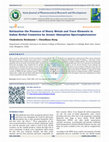
Asian Journal of Pharmaceutical Research and Development, 2019
Heavy metals are identically Pb, Cd and micronutrients elements like Ca, Mg, Al, Cu and Zn were q... more Heavy metals are identically Pb, Cd and micronutrients elements like Ca, Mg, Al, Cu and Zn were quantitatively estimated using Flame Atomic Absorption Spectrometry (FAAS). Similarly, heavy metals such as As and Hg were quantitatively estimated by Hydride Generation Technique i.e. Cold Vapor Atomic Absorption Spectrometry method expending nitrogen as carrier gas in 30 herbal cosmetic preparations available in Indian markets. The results designate that among the toxic heavy metals. In the present study, Arsenic was found significantly well below the permissible limit, but Cd was found above the permissible limit in the all samples. Trace elements like Ca and Mg were found in higher amount than compare to Al, Cu, and Zn. Presence of trace elements can corroborate to be beneficial but existence of toxic heavy metals in such amounts certainly has adverse effects on the consumer health who always take the herbal products in an impression of being safe because of the natural origin. In con...
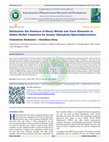
Asian Journal of Pharmaceutical Research and Development, 2019
Heavy metals are identically Pb, Cd and micronutrients elements like Ca, Mg, Al, Cu and Zn were q... more Heavy metals are identically Pb, Cd and micronutrients elements like Ca, Mg, Al, Cu and Zn were quantitatively estimated using Flame Atomic Absorption Spectrometry (FAAS). Similarly, heavy metals such as As and Hg were quantitatively estimated by Hydride Generation Technique i.e. Cold Vapor Atomic Absorption Spectrometry method expending nitrogen as carrier gas in 30 herbal cosmetic preparations available in Indian markets. The results designate that among the toxic heavy metals. In the present study, Arsenic was found significantly well below the permissible limit, but Cd was found above the permissible limit in the all samples. Trace elements like Ca and Mg were found in higher amount than compare to Al, Cu, and Zn. Presence of trace elements can corroborate to be beneficial but existence of toxic heavy metals in such amounts certainly has adverse effects on the consumer health who always take the herbal products in an impression of being safe because of the natural origin. In conclusion, execution of strict and isolated regulatory guidelines and promotion of Good Analytical Practice (GAP), Good Manufacturing Practices (GMP) and Good Agricultural and Control Practices (GACP) is suggested for herbal cosmetics by WHO and other regulatory agencies. This study presents the status of heavy metals and trace elements in marketed herbal cosmetic formulations and provides a simple and convenient AAS method which can effectively be adopted at Industrial level for the quality control and standardization of herbal cosmetic preparations and other related products.

Over so many decades, oral route still holds the level of the most favourite route of drug admini... more Over so many decades, oral route still holds the level of the most favourite route of drug administration in a no. of disease conditions. Even today, it is the primary route for delivering the drug in most of the developmental cases. However, the major drawback of such route involves the poor aqueous solubility, resulting in unsatisfactory oral drug delivery for more than 40% of new drug entities. Such problem leads to high inter- and intra-patient variability, dose proportionality lacked and sometimes therapeutic failure. But recent advancements put forth attention towards much focussed self-emulsifying drug delivery systems (SEDDS) in order to improve the oral bioavailability of poorly aqueous soluble drugs, enabling reduction in dose, consistent profiles of drug absorption, selective targeting of drug(s) towards specific absorption in GIT and protection of drug(s) from the hostile environment in gut. This article emphasises on an overview of the new advancements in this field wit...
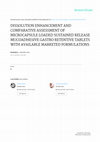
Losartan potassium is a non-peptide molecule and selective competitive angiotensin II type 1 rece... more Losartan potassium is a non-peptide molecule and selective competitive angiotensin II type 1 receptor (AT1) receptor antagonist which is mainly used as a first line treatment for the patients suffering from hypertension. In the present research work Losartan potassium loaded microcapsules were fabricated by using modified double emulsion solvent evaporation method and further more they were incorporated into mucoadhesive gastro retentive tablets. The release kinetic of the prepared tablets was evaluated by using PCP Disso V3® software and it selected ‘zero order’ model as the best fitting model, supporting the sustained release property of the final oral dosage forms which was the primary objective of the present study. Final formulations were subjected to comparison with three different marketed conventional dosage forms on the basis of dissolution property and it showed better release pattern than the rest.
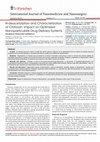
Context: An attempt has been made to modify the natural polymer (chitosan) to its deacetylated fo... more Context: An attempt has been made to modify the natural polymer (chitosan) to its deacetylated form to enhance its physico-chemical properties with improved feasibility in nanoparticulate delivery systems for stability and reproducibility. Objective: Deacetylation of chitosan was processed by removal of branched acetyl group in order to increase the polymer stability for particulate drug delivery systems with enhanced physical and process dependent properties. Alongside, preparation of deacetylated chitosan based drug loaded nanoparticles for determining its impact on formulation process and stability. Materials and methods: Chitosan is poly [(1,4)-2-amino-2-deoxy-D-glucopyranose], a copolymers of N-acetyl-D-glucosamine and D-glucosamine (backbone chains). N-deacetylation was performed using modified alkali reduction method to get ≥99% deacetylation. Later on, nanoparticles were prepared and characterized with optimization accordingly. Results and discussion: Implemented polymer characterization: physical parameters, solubility, degree of deacetylation, viscosity and crystallinity shown desired properties. Alongside, application based evaluations, i.e., screened and optimized preparation of nanoparticles with characterization and in vitro release behaviour. Conclusion: Desirable changes in chitosan properties and the subsequent reproducibility of nanoparticles prepared with promising results, paves the way towards extensive research in modifications of existing natural polymers for better reproducibility at reduced costs and higher commercialization probability.

This review focusses on the current ongoing research in the field of tuberculosis comprising the ... more This review focusses on the current ongoing research in the field of tuberculosis comprising the resistant strains.
It specifies a proper data analysiswith results in concise form fromareas gripping in: diagnostic nanotechnology,
vaccine nanotechnology and the prime field of interest i.e., therapeutic nanotechnology. Primarily, therapeutic
area recollects the research findings from advanced drug delivery (primary era) to the targeted drug delivery
(modern era). The vaccine-based area derives the immune-specific targetingwith enhancedemphasis on vaccine
extraction and preparation of nanoparticles. Finally, the diagnostic area signifies the imaging techniques that may
be employed in the diagnosis of TB. Not only that, there are some researches that emphasized on finding the
comparable diagnostic differences between normal and resistant strains. With the advent of carbon nanotubes,
metallic NPs, a newer hope has emerged out in diagnostic research, which may extend to therapeutic research
applications too. Modifications of natural polymers, least or no use of organic solvents, size controlled NPs, optimized
methodology, etc., are fields that need more effort to bypass toxicity. If above desired possibilities get the
priority during research, it may lead to shift in the timeline towards much more oriented research.
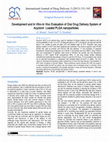
Acyclovir (ACV) is an antiviral drug, used for treatment of herpes simplex virus infections with ... more Acyclovir (ACV) is an antiviral drug, used for treatment of herpes simplex virus infections with an
oral bioavailability of only 10 to 20 % (limiting absorption in GIT to duodenum and jejunum),half-life
about 3 hrs, soluble at acidic pH (pKa 2.27) and distilled water at 37ºC. Polymeric nano drug
delivery systems of ACV have been designed and optimized. Poly (lactic-co-glycolic acid) (PLGA)
(50:50) was used as polymer and Pluronic F68 was stabilizer. In vitro evaluation of prepared
formulations showed drug entrapment up to 90.06 % and particle size from 395nm. Drug: Polymer
ratio and concentration of stabilizer were found to influence the particle size and entrapment
efficiency of ACV loaded PLGA nanoparticles (NPs). In vitro drug release studies indicated
controlled and sustained drug release of drug for a period of 32 hours. In vivo evaluation was carried
out for selected formulations in comparison with marketed tablet (Zovirax®) in rabbits. The AUC
values for developed formulations clearly indicated two to three fold improvement in bioavailability of
ACV when compared to Zovirax® tablets. These preliminary results indicate ACV NPs are superior
to marketed tablet Zovirax® as particle size and release rate of entrapped drug is controlled, which
results in enhanced bioavailability and probable decrease in dose and dosing frequency. Ultimately
increasing adherence to drug therapy and patient comfort.
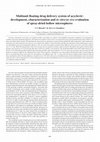
Acyclovir, anti-herpes virus drug, was loaded in hollow microspheres to improve bioavailability a... more Acyclovir, anti-herpes virus drug, was loaded in hollow microspheres to improve bioavailability and patient compliance by prolonging the residence time in the gastrointestinal tract. The hollow microspheres of acyclovir were prepared by spray-drying method using ethyl cellulose as a drug-controlled release polymer. We found that the selected process parameters of spray-drying method like inlet temperature, outlet temperature, polymer concentrations were less buoyant than those with lower polymer concentrations. The formulation HSF1 showed the highest buoyancy of plot it was found that drug release from the microspheres was diffusion type. The 'n' values from Korsmeyer-peppas model indicated that all three formulations follow Fickian diffusion controlled release. The AUC values for oral administration of selected formulation and conventional tablet (Zovirax) clearly indicated two-to three-fold improvement in the bioavailability of acyclovir from prepared formulation when compared to conventional commercial tablet.
Teaching Documents by SURAJ CHOUDHARY
A sophisticated write-up which explains every aspect of drug delivery through transdermal route. ... more A sophisticated write-up which explains every aspect of drug delivery through transdermal route. Mostly focuses on its formulation based approaches with characterization and evaluations. Alongside, some basic information related to its invivo and pharmacokinetic studies also enclosed.
A complete overview with focus on drug delivery











Uploads
Papers by SURAJ CHOUDHARY
It specifies a proper data analysiswith results in concise form fromareas gripping in: diagnostic nanotechnology,
vaccine nanotechnology and the prime field of interest i.e., therapeutic nanotechnology. Primarily, therapeutic
area recollects the research findings from advanced drug delivery (primary era) to the targeted drug delivery
(modern era). The vaccine-based area derives the immune-specific targetingwith enhancedemphasis on vaccine
extraction and preparation of nanoparticles. Finally, the diagnostic area signifies the imaging techniques that may
be employed in the diagnosis of TB. Not only that, there are some researches that emphasized on finding the
comparable diagnostic differences between normal and resistant strains. With the advent of carbon nanotubes,
metallic NPs, a newer hope has emerged out in diagnostic research, which may extend to therapeutic research
applications too. Modifications of natural polymers, least or no use of organic solvents, size controlled NPs, optimized
methodology, etc., are fields that need more effort to bypass toxicity. If above desired possibilities get the
priority during research, it may lead to shift in the timeline towards much more oriented research.
oral bioavailability of only 10 to 20 % (limiting absorption in GIT to duodenum and jejunum),half-life
about 3 hrs, soluble at acidic pH (pKa 2.27) and distilled water at 37ºC. Polymeric nano drug
delivery systems of ACV have been designed and optimized. Poly (lactic-co-glycolic acid) (PLGA)
(50:50) was used as polymer and Pluronic F68 was stabilizer. In vitro evaluation of prepared
formulations showed drug entrapment up to 90.06 % and particle size from 395nm. Drug: Polymer
ratio and concentration of stabilizer were found to influence the particle size and entrapment
efficiency of ACV loaded PLGA nanoparticles (NPs). In vitro drug release studies indicated
controlled and sustained drug release of drug for a period of 32 hours. In vivo evaluation was carried
out for selected formulations in comparison with marketed tablet (Zovirax®) in rabbits. The AUC
values for developed formulations clearly indicated two to three fold improvement in bioavailability of
ACV when compared to Zovirax® tablets. These preliminary results indicate ACV NPs are superior
to marketed tablet Zovirax® as particle size and release rate of entrapped drug is controlled, which
results in enhanced bioavailability and probable decrease in dose and dosing frequency. Ultimately
increasing adherence to drug therapy and patient comfort.
Teaching Documents by SURAJ CHOUDHARY
It specifies a proper data analysiswith results in concise form fromareas gripping in: diagnostic nanotechnology,
vaccine nanotechnology and the prime field of interest i.e., therapeutic nanotechnology. Primarily, therapeutic
area recollects the research findings from advanced drug delivery (primary era) to the targeted drug delivery
(modern era). The vaccine-based area derives the immune-specific targetingwith enhancedemphasis on vaccine
extraction and preparation of nanoparticles. Finally, the diagnostic area signifies the imaging techniques that may
be employed in the diagnosis of TB. Not only that, there are some researches that emphasized on finding the
comparable diagnostic differences between normal and resistant strains. With the advent of carbon nanotubes,
metallic NPs, a newer hope has emerged out in diagnostic research, which may extend to therapeutic research
applications too. Modifications of natural polymers, least or no use of organic solvents, size controlled NPs, optimized
methodology, etc., are fields that need more effort to bypass toxicity. If above desired possibilities get the
priority during research, it may lead to shift in the timeline towards much more oriented research.
oral bioavailability of only 10 to 20 % (limiting absorption in GIT to duodenum and jejunum),half-life
about 3 hrs, soluble at acidic pH (pKa 2.27) and distilled water at 37ºC. Polymeric nano drug
delivery systems of ACV have been designed and optimized. Poly (lactic-co-glycolic acid) (PLGA)
(50:50) was used as polymer and Pluronic F68 was stabilizer. In vitro evaluation of prepared
formulations showed drug entrapment up to 90.06 % and particle size from 395nm. Drug: Polymer
ratio and concentration of stabilizer were found to influence the particle size and entrapment
efficiency of ACV loaded PLGA nanoparticles (NPs). In vitro drug release studies indicated
controlled and sustained drug release of drug for a period of 32 hours. In vivo evaluation was carried
out for selected formulations in comparison with marketed tablet (Zovirax®) in rabbits. The AUC
values for developed formulations clearly indicated two to three fold improvement in bioavailability of
ACV when compared to Zovirax® tablets. These preliminary results indicate ACV NPs are superior
to marketed tablet Zovirax® as particle size and release rate of entrapped drug is controlled, which
results in enhanced bioavailability and probable decrease in dose and dosing frequency. Ultimately
increasing adherence to drug therapy and patient comfort.